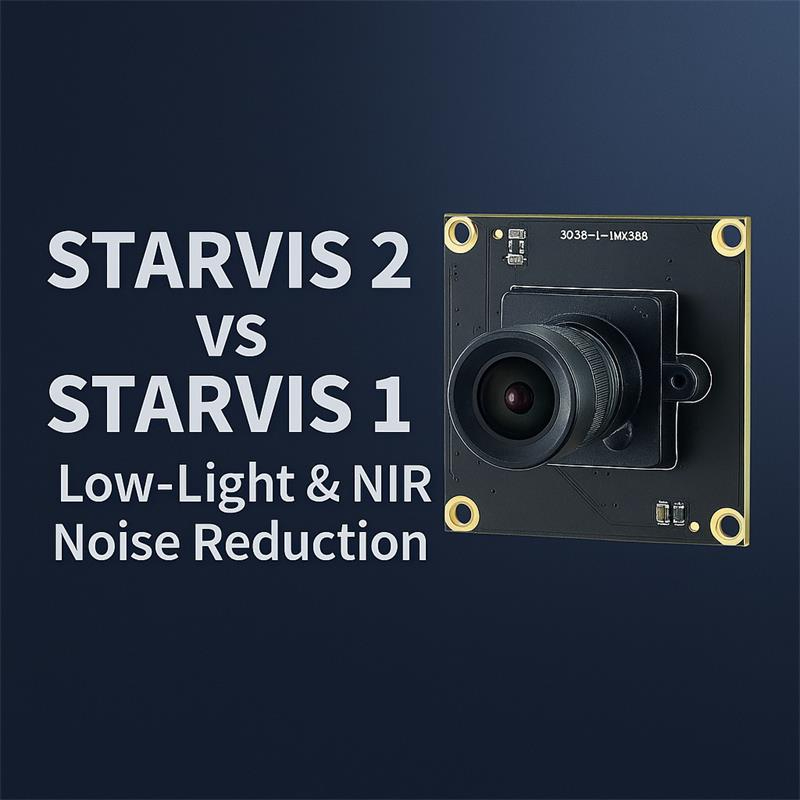
In the field of industrial machine vision, Sony’s STARVIS series has gained significant attention for its exceptional low-light imaging capabilities. From STARVIS 1 to STARVIS 2, Sony has implemented multiple optimizations and innovations, significantly enhancing sensor performance in complex industrial environments.
STARVIS 1 adopted a back-illuminated pixel structure, placing the photodiode above the wiring layer to reduce light loss from reflection or absorption before reaching the photodiode—improving sensitivity to a certain degree. Building on this, STARVIS 2 further refines the process and structural design, dramatically improving light collection efficiency.
Incoming light now reaches the photodiode almost without loss. Compared to STARVIS 1, STARVIS 2’s light-gathering ability in extremely dark environments is improved by about 4.6×. Under illumination as low as 0.009 lx, STARVIS 2 sensors can still capture enough light signals to produce relatively clear images, whereas STARVIS 1 would show significant quality degradation and detail loss in similar conditions.
STARVIS 2 increases pixel size, providing a larger “capture area” for light collection. Larger pixels hold more photons, boosting sensitivity to weak light. The new pixel layout also reduces crosstalk between pixels, improving signal accuracy. For example, in a 5MP STARVIS 2 sensor, the pixel size is increased by [X]% compared to an equivalent STARVIS 1 sensor, improving SNR by [X] dB in low-light images—producing cleaner, more detailed results. In an industrial night warehouse inventory task, this allows small text on cargo labels to be clearly read.
In industrial imaging, NIR illumination is often used for assistance. STARVIS 2 incorporates irregular structures on the photodiode’s incident plane to refract incoming NIR light more effectively, improving absorption. Test data shows STARVIS 2’s NIR sensitivity is ~2.5× higher than STARVIS 1.
In complete darkness with NIR illumination, STARVIS 2 cameras can clearly capture object contours and textures, whereas STARVIS 1 produces blurrier images with less detail. This advantage is vital for tasks like nighttime automotive parts inventory and equipment inspection in dark environments.
STARVIS 2’s superior NIR performance extends industrial vision into light-sensitive environments where visible light is undesirable—such as food processing (avoiding visible light’s impact on quality) or optical component manufacturing (preventing visible light interference). Here, STARVIS 2 enables precise monitoring, while STARVIS 1’s weaker NIR sensitivity limits application viability.
Industrial environments often feature mixed lighting—bright and dark areas coexisting. While STARVIS 1 had a moderate dynamic range, it struggled with extreme contrast. STARVIS 2’s optimized photodiode structure allows it to store more photons, boosting dynamic range. Using single exposure, STARVIS 2 reaches 78 dB DR, about 2.5× that of STARVIS 1.
In a workshop, STARVIS 2 can capture both the reflective detail of metal surfaces in bright light and wiring details in shaded areas, avoiding STARVIS 1’s overexposed highlights and underexposed shadows—delivering more accurate inspection results.
In rapidly changing lighting scenarios—like forklift headlights flashing in warehouses or varying illumination between production stations—STARVIS 2 adapts quickly, maintaining stable, high-quality output. In contrast, STARVIS 1 may suffer from flicker or unstable brightness, reducing detection accuracy.

In dynamic machine vision, such as inspecting fast-moving products on a conveyor, STARVIS 1’s traditional DOL HDR suffers from motion artifacts because it captures bright and dark frames sequentially before combining them—creating time-shift color fringing or blur.
STARVIS 2’s Clear HDR applies gain before capture, then simultaneously acquires images at different exposures for combination—eliminating time-shift artifacts.
On a high-speed PCB SMT line, STARVIS 2 captures moving components without artifacts or color shifts, enabling accurate inspection of component positions and solder quality—whereas STARVIS 1 may produce blurred edges.
In automation scenarios requiring real-time monitoring of moving targets—such as cobots navigating and interacting with surroundings—Clear HDR ensures accurate detection of object position and posture, avoiding misoperations caused by image artifacts. This greatly enhances stability and reliability compared to STARVIS 1.
STARVIS 2 uses a stacked structure with Cu-Cu connections between pixel and circuit layers, optimizing high-speed signal processing layout. Compared to STARVIS 1, this shortens signal paths, reducing energy loss. Tests show STARVIS 2 power consumption is about 30% lower than STARVIS 1.
For 24/7 industrial surveillance systems, this lowers overall energy use, cuts operating costs, reduces heat buildup, and extends device lifespan—while STARVIS 1’s higher power draw may cause overheating and image instability.
In high-stability-demand environments—such as power facility inspections or chemical production monitoring—STARVIS 2’s lower power draw reduces system failure risks, ensuring continuous, reliable vision monitoring. STARVIS 1 is comparatively less efficient here.

STARVIS 1 Series
STARVIS 2 Series